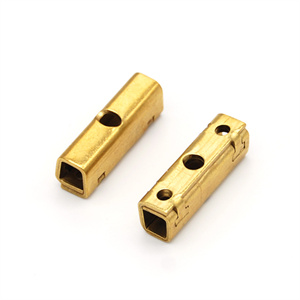The main materials commonly used for electrical contacts are as follows:
Silver: Silver has excellent electrical and thermal conductivity, so it is widely used in high-frequency circuits, precision instruments and other fields. However, due to the low hardness of silver and the low melting and boiling points, it is usually only used for small current contacts, such as relays, etc. For high-current contacts, silver alloys or composites are often used.
Copper: Copper is another important material in electrical contacts, with good conductivity and wear resistance. It is widely used in relays, switches and other components. However, copper is susceptible to oxidation in the air, especially at high temperatures, and an oxide film will form on its surface, affecting the contact resistance and performance. Despite this, considering factors such as electrical conductivity, arc resistance, and price, copper is still the most widely used contact material.
Alloy materials: Alloy materials are also widely used in electrical contacts. For example, silver alloy contacts are often used in demanding switchgear due to their good electrical and thermal conductivity and good solderability. Nichrome contacts have high hardness and good wear resistance, which is suitable for occasions that require frequent switching. In addition, there are tungsten alloy contacts, which have the characteristics of high hardness, high melting point, high temperature resistance, corrosion resistance, etc., and are often used in switchgear that requires high temperature and high pressure, high current, high mechanical strength and other special environments.
Materials commonly used by Electrical Contact Materials include the following:
Silver: very good conductivity and thermal conductivity, low contact resistance, a kind of high-quality electrical contact material. Commonly used in precision electrical appliances requiring low contact resistance and high conductivity, such as high-quality relays and switches. In some high-end communication equipment, precision relays will use silver as the electrical contact material to ensure the accuracy and stability of signal transmission.
Copper: Good conductivity and relatively low price. However, they are relatively weak in oxidation and wear resistance and are often surface treated or alloyed with other elements to improve performance. In some common electrical equipment, such as common low-voltage circuit breakers, treated copper may be used as the electrical contact material.
Tungsten: high melting point, high hardness, good arc ablation resistance, commonly used in high-voltage switch and arc discharge equipment. Like some large high-voltage power switches, tungsten is often used to make electrical contact parts to withstand high voltage and high current generated arcs.
Silver-tungsten alloy: It combines conductivity of silver and arc ablation resistance of tungsten, and is commonly used for switchgear with large current and high voltage.
Silver-nickel alloy:
It improves the abrasion resistance and fusion resistance of silver and is widely used in various contactors and relays.
In addition to the above-mentioned materials, tungsten, molybdenum, titanium alloys, etc. are also used as electrical contact materials in certain situations. For example, tungsten and molybdenum are not easily oxidized at high temperatures and pressures, so they are often used in electrical contacts. Titanium alloys are used in marine, aviation and other fields because of their good chemical stability and corrosion resistance.
The selection of electrical contact materials needs to be carried out according to the specific use environment and needs. Different materials have different characteristics and scope of application, and should be selected according to the actual situation.
